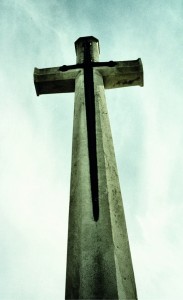Commonwealth War Graves Commission Cross of Sacrifice to be erected at Glasnevin Cemetery
Published in Features, Issue 4 (July/August 2014), Volume 22
A Cross of Sacrifice, similar to the one to be unveiled in Glasnevin Cemetery on 31 July 2014.
One particularly striking example of an Irishman who served with both the British and republican forces is Martin Doyle, a pre-war regular from Wexford who enlisted in the Royal Irish Regiment in 1909. On the outbreak of war in 1914 he transferred to the Royal Dublin Fusiliers, and by 1915 he had been promoted to the rank of sergeant. During the great German spring offensive of 1918, Doyle was awarded the Military Medal for gallantry under fire. This clearly exceptional soldier went on to be awarded the Victoria Cross for an act of extraordinary bravery the following September during the so-called 100 Days campaign that ended the war on the Western Front. Doyle was demobilised at the end of 1919 and throughout 1920 and ’21 he used his connections with the military to act as intelligence officer for the Mid-Clare Brigade of the IRA. He served with the Free State forces during the Civil War and was wounded while fighting in Limerick early in 1923. Doyle remained in the National Army until his retirement in 1937. He died in November 1940 and is buried at Grangegorman military cemetery on Blackhorse Avenue, where he lies beneath a headstone erected and paid for by his old comrades in the Munster Fusiliers.
During the 1920s, a Cross of Sacrifice was erected at most of the newly established Imperial (now Commonwealth) War Graves Commission cemeteries containing over 40 burials. Designed by the renowned architect Sir Reginald Blomfield, the Cross of Sacrifice represents the Christian faith of the majority and the human sacrifice of all the dead of the British Empire. These simple stone crosses with embedded bronze sword can be found in cemeteries across the globe wherever Commonwealth servicemen were laid to rest during and after the two world wars. One exception is the Republic of Ireland. Although over 2,600 men who died as a result of service during the First World War are buried in the Republic, the installation of Crosses of Sacrifice was unwelcome in the political and cultural climate of the 1920s in what was then the Irish Free State. The issue of erecting crosses in the Republic is further complicated by the fact that, unlike Belgium and France, the Commission owns none of the Irish burial grounds. Unlike most other war cemeteries across the globe, moreover, the day-to-day mainten-ance of ‘British’ burial sites in the Republic is not funded by the Commonwealth War Graves Commission (CWGC) but by the Irish government and is carried out by the OPW. All overseeing and major maintenance work performed by the Commission therefore has to be done in cooperation with the Irish state through the OPW. The significant improvement in Anglo-Irish relations since the mid-1990s and the increased Irish interest in the First World War have led to a commensurate improvement in working relations and general communication between the CWGC and the OPW. As we approached the various centenaries, it was thus felt that the time was right to finally erect a Cross of Sacrifice in one of the six war grave locations in the Republic. The proposal was warmly received by the Glasnevin Trust and the Irish government, and the cross will be unveiled at the cemetery on 31 July 2014. The presence of a major monument to Commonwealth soldiers amongst the colourful range of nationalist and republican memorials at Glasnevin serves to underline the overlapping experiences of our ancestors.
Edward Madigan was Resident Historian at the Commonwealth War Graves Commission 2011–13.
Read More: Shane MacThomáis
















